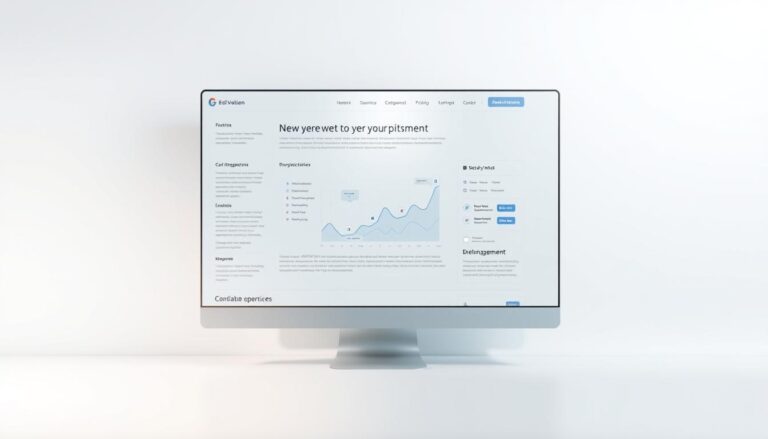In today’s world, having a customized workflow optimization is essential. Companies use updated methods and tech tools to make their work better and faster. This kind of optimization is more than just doing tasks quickly.
It involves making systems that perfectly fit your business needs. This helps boost your team’s work rate and cuts down on waste.
Improving business processes means finding problems, making tasks simpler, and using smart automation. These steps not only make things faster but also improve how the whole organization works. This leads to happier employees and more profits for the business.
Therefore, it’s clear that optimized workflow solutions are crucial. They are a must for any business wanting to do well in today’s competitive world.
Key Takeaways
- Embracing customized workflow optimization is crucial for organizations to adapt quickly to market demands and reduce waste in their processes.
- Incremental yet continuous improvement is favored over broad overhauls, indicating a strategic and manageable approach to workflow refinement.
- Business agility and reduced waste are direct benefits of optimized workflow solutions, impacting customer relations significantly.
- Adopting high-level strategies such as Lean, Six Sigma, and Agile allows for the identification and mitigation of inefficiencies.
- Workflow optimization not only enhances employee productivity but also plays a critical role in maintaining high data integrity and security standards.
- Standardized, well-optimized workflows ensure organizational agility, enabling quick responses to market shifts and a competitive edge.
- Increased transparency and accountability from workflow optimization foster a culture of productivity and clear task delineation.
The Imperative of Personalized Process Improvement for Business Efficiency
In our competitive world, focusing on personalized process improvement is crucial. It drives efficiency and puts companies ahead. By looking closely at their own processes, businesses can work better in all areas.
Improving processes reduces unnecessary steps and mistakes. This is true in customer service, marketing, and daily tasks. By making processes fit the company’s needs, businesses save money and work faster. They also make fewer errors and get more done.
Bespoke workflow management systems are key for ongoing improvement and flexibility. Such systems help companies quickly adjust to new market trends and internal changes. For instance, custom software makes workflows faster and better. This leads to happier customers and a stronger position in the market.
| Statistic | Impact |
|---|---|
| Reduction in Operational Costs | 15% |
| Improvement in Customer Satisfaction | 25% |
| Efficiency Increase with Custom Solutions | 20% |
| Productivity Increase with Custom Solutions | 10-15% |
| Companies Outperforming Competitors | 33% |
Statistics show how much personalized process improvement helps businesses. Using tools like Kaizen and the PDCA cycle makes operations better. This leads to lower costs and happier customers.
For businesses wanting to lead, customized solutions are essential. They make processes smoother and encourage teams to keep improving. This is how companies stay ahead.
Customized Workflow Optimization: The Bedrock of Streamlined Operations
In our fast-changing business world, customized business process optimization is key. It boosts efficiency and growth over time. By making workflows that fit a company’s specific needs, businesses improve how they work. This leads to better productivity and lower costs.

When you tailor workflows, it means adding automation for repetitive tasks. This lets people focus on more complex and creative tasks. For example, using automation software speeds things up and keeps them accurate. This is especially good in jobs where making the same mistake is not an option.
Unique workflow enhancement also means using tech smartly to help with communication and making choices faster. Tools like AI and machine learning help in predicting trends. This helps businesses react quickly to new challenges.
- Task batching reduces cognitive load and increases focus.
- Delegation leverages individual strengths, enhancing overall team performance.
- Technological integration with tools like CloudApper optimizes existing systems and introduces advanced capabilities.
- Ergonomic adjustments reduce physical strain and improve efficiency.
This table shows how different strategies in customized workflow optimization benefit businesses.
| Strategy | Benefits |
|---|---|
| Automation | Time savings, error reduction, cost efficiency |
| Task Delegation | Enhanced focus on strategic planning, better use of skills |
| Technological Integration | Improved system compatibility, enhanced data analytics |
| Ergonomic Design | Increased comfort, reduced downtime, higher productivity |
Focusing on customized business process optimization doesn’t just make things quicker. It’s about being smarter and creating a foundation for lasting success in a digital future.
Strategies for Achieving Tailored Workflow Efficiency
In the business world, finding ways to improve workflow is crucial. We explore strategies to boost efficiency and exceed expectations. This includes recognizing bottlenecks, using process automation, and employing custom optimization tools.
Identifying and Eliminating Process Bottlenecks
Analyzing workflows helps find and fix slowdowns. With tools like flowcharts or Gantt charts, companies can see where manual entries and extra steps slow things down. Using lean principles helps by reducing waste and enhancing value.
Implementing Specialized Process Automation
Using automation is key to reducing human mistakes. SmartSuite and Jira automate tasks and improve communication. They ensure tasks are done on time and accurately, boosting speed and reliability.
Leveraging Custom Business Process Optimization Tools
For ongoing improvement, it’s important to use advanced software that monitors performance. SmartSuite offers tools for various business areas, like Sales and HR. It helps teams work better together towards shared goals, improving decision-making and planning.
Looking ahead, using AI tools and personalizing workflows will keep businesses competitive. Adapting to changes and optimizing workflows is key to staying ahead.
To wrap up, enhancing workflow efficiency involves several key steps. Identifying bottlenecks, automating processes, and using custom tools are all critical. These efforts improve operations and set the stage for future innovations in how work gets done.
Exclusive Workflow Design and Its Impact on Industry Leaders
In the business world, exclusive workflow design greatly improves performance and simplifies tasks. This is especially true in areas like healthcare and customer service. Here, mixing methods such as Six Sigma with automation boosts both efficiency and output quality. This approach is key in situations where quick, high-quality reactions are vital for client or patient outcomes.
Studies show that better workflows in healthcare mean better patient care and more efficient operations. By changing service processes and roles, and using teams to rethink workflows, we see great results. Research demonstrates that well-planned operations can cut procedural times and increase throughput. This shows the power of thoughtful workflow design.
Critical process insights reveal that a streamlined, collaborative approach, which employs both role definition and technological aid, maximizes resource utilization and minimizes operational slack, thereby directly impacting the quality of client engagements and operational throughput.
In customer services, using special automation tools in workflows is crucial. Data shows more than half of consumers leave a brand after one bad service experience. This highlights the need for well-crafted workflows. They must ensure quick and efficient responses to keep service quality high.
The rise of AI in customer interactions and CRM systems marks a big change. Adding AI to CRM workflows leads to faster replies, customized messages, and happier customers. It’s a perfect example of combining automation with special workflow design for better service.
To sum up, using exclusive workflow designs and automation is a major strategic move. It not only boosts how well operations work but also promotes constant improvements. Leaders in industries who focus on these aspects will see better efficiency, customer happiness, and overall success.
Optimized Workflow Solutions: Selecting the Right Software
Choosing the right software is crucial for better workflow. It involves knowing workflow automation features and the benefits of software integration. These factors make business operations more agile and improve decision-making.
Key Features of Workflow Automation Software
Workflow software reduces manual work and cuts payroll costs. For instance, CCH Axcess Workflow saves each employee about 1.5 hours a day. It does this by automating the tracking of tasks and updating all involved instantly.
This reduces the time looking for updates by 12 minutes and report making by 10 minutes.
Integrating ERP systems, CRM systems, and e-commerce with workflow software improves operations greatly. Jira, for example, helps companies automate tasks, assign tasks, and monitor progress. This makes task management more consistent and efficient.
Software Integration for Enhanced Process Visibility
Good software integration allows different systems, like ERP and CRM, to communicate well. This is key for optimized workflows. It leads to efficient data sharing and better decision-making.
Jira integrates well with other apps, which boosts efficiency in managing tasks. Its tools like automation rules and advanced roadmaps offer real-time visibility and team coordination. This helps in making fast, informed decisions for business success.
In the end, using strong workflow automation software simplifies daily tasks and supports strategic business growth. It also increases customer satisfaction over the long term.
Sustaining and Expanding Individualized Workflow Streamlining
In today’s fast-paced business world, individualized workflow streamlining is key for success. Employers are focusing more on improving their enterprise resource planning systems. This helps make processes better and ensures effective workflow optimization.
Understanding automation’s role in reducing administrative work is essential. Did you know? 34% of companies say automation cuts down time spent on admin tasks. Moreover, 28% report quicker responses to leads. Automation makes tasks like data entry more accurate and saves precious time. This turns technology into a vital part of improving business processes.

- Boosting Customer Service: 35% of businesses say automation tools have improved their customer service.
- Enhanced Cloning Features: Deep Clone for Jira shows how tech can revolutionize processes. What used to take hours for over 65 issues now takes just 6 minutes. This saves up to 90% of time.
- Project and Time Management: Tools like Phoenix’s AI Time Manager and Project Accelerator better manage tasks. They help use resources wisely and cut down on wasted time.
Adding AI tools helps businesses adapt faster. They enable real-time decisions and smoother communication.
| Tool | Function | Impact |
|---|---|---|
| Phoenix’s AI Meeting Flow Optimizer | Automates meeting summaries and action item tracking | Reduces miscommunications and makes roles clear |
| Phoenix’s AI Decision Powerhouse | Uses predictive analytics for better workflow | Speeds up making informed decisions |
| Phoenix’s AI Collaboration Tools | Helps with real-time updates and teamwork, even remotely | Boosts team effectiveness and project timelines |
As industries evolve, advanced ERP systems and workflow tools are crucial. They help organizations lead in efficiency and innovation.
Conclusion
Exploring ways to make work flow better shows that smart strategies boost business. These methods make companies strong in a fast-paced world. By finding unnecessary steps, using smart tech, and getting employees involved, businesses can change a lot for the better.
For example, companies can save employees 12 hours a week looking for information. This is according to a fact shared by Airtable. With better workflows, employees can focus more and feel more a part of the team.
Different industries, like call centers using Six Sigma, show how adjusting work processes helps a lot. Principles from lean manufacturing help healthcare become more efficient. Tools like Bonsai help businesses run smoother, increase teamwork, and boost efficiency.
Also, keeping an eye on progress and making regular checks help businesses grow over time. This lets them stay quick to respond to new market needs.
Using tech to automate work helps break down barriers between departments. This boosts teamwork and makes information flow better. With tools like Bonsai, companies see big improvements in work and project results.
Automation lowers mistakes, keeps things consistent, and raises accountability. It makes customer experiences better and helps the company save money.
FAQ
What is customized workflow optimization?
Customized workflow optimization is about making business processes better. It aims to boost efficiency and cut down on waste. This helps in doing jobs better and making more profit.
It can involve using new tech and removing steps that slow things down. Simplifying tasks is also key to getting things done faster.
How does personalized process improvement drive business efficiency?
Personalized process improvement looks closely at how work gets done. It changes things to fit a company’s unique needs. This can lead to spending less, making fewer mistakes, and finishing tasks quicker.
Why is customized workflow optimization foundational for streamlined operations?
Customized workflow optimization is key because it brings in automation. It keeps those in charge updated without unnecessary steps. Quality and consistency stay high, no matter who is working.
What does identifying and eliminating process bottlenecks involve?
To tackle bottlenecks, you have to first find them by looking at how work flows. Then, you might need to change the workflow to make things run smoother. This often means using diagrams to see where problems lie.
What is specialized process automation?
Specialized process automation uses tech to do tasks without mistakes. It’s made just for an organization’s needs. This helps things run the same way every time, boosting how well an operation works.
How can leveraging custom business process optimization tools benefit a company?
Using custom tools can help a company by giving insights in real time. They help in keeping track, evaluating work, and holding people accountable. This leads to better results and more efficient work.
What impact does exclusive workflow design have on industry-specific operations?
Exclusive workflow design improves how industries operate. It solves problems and makes workflows better. In healthcare and customer service, it brings consistency and better service for customers.
What should be the key features of workflow automation software?
Workflow automation software should keep track of data and update everyone involved. It should cut down on the need for people to step in. This helps save money and makes the work go smoother.
Why is software integration important for enhanced process visibility?
Software integration is important because it makes different systems work together. This helps in making better decisions. Good decisions mean better control and a clearer view of operations.
How can an organization sustain individualized workflow streamlining?
An organization can keep workflow improvements going by regularly checking on things. They should talk to employees, listen to their ideas, and train them. This creates a culture where things always get better.



